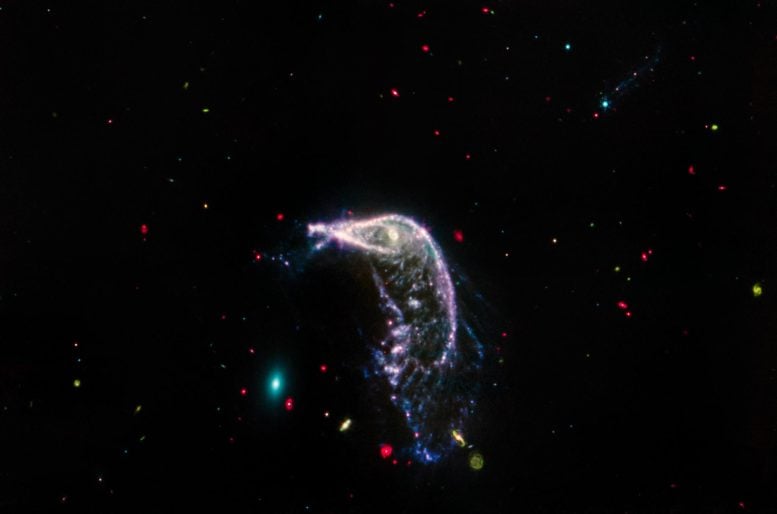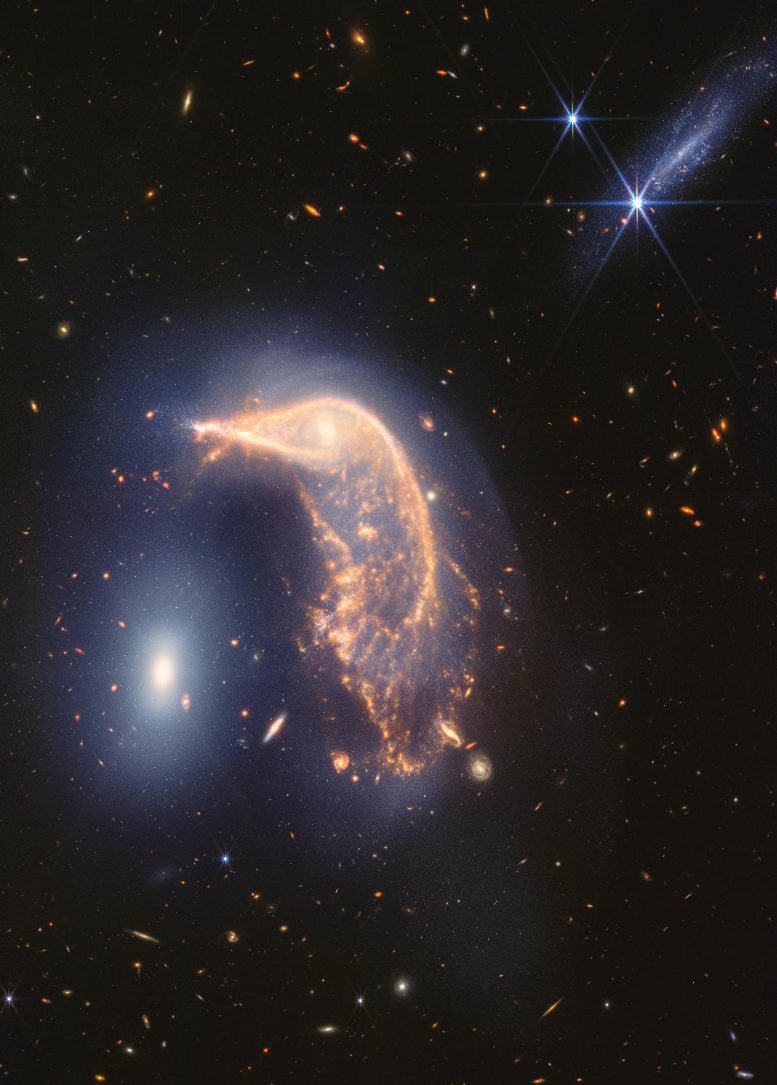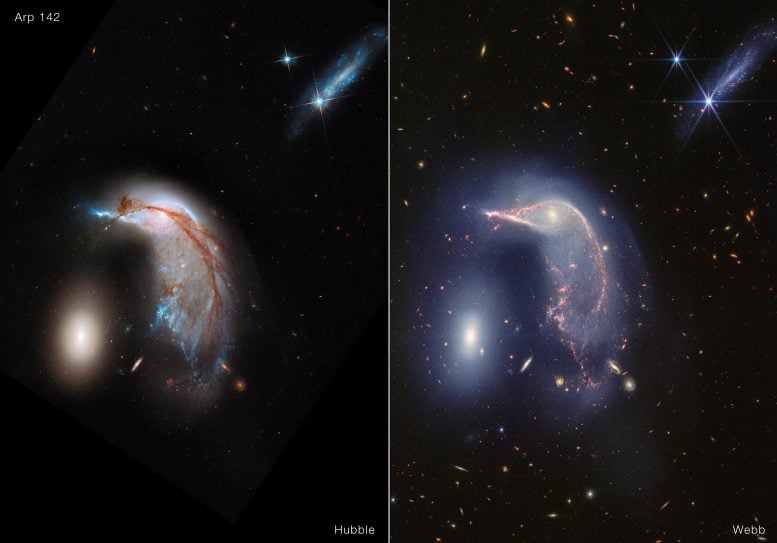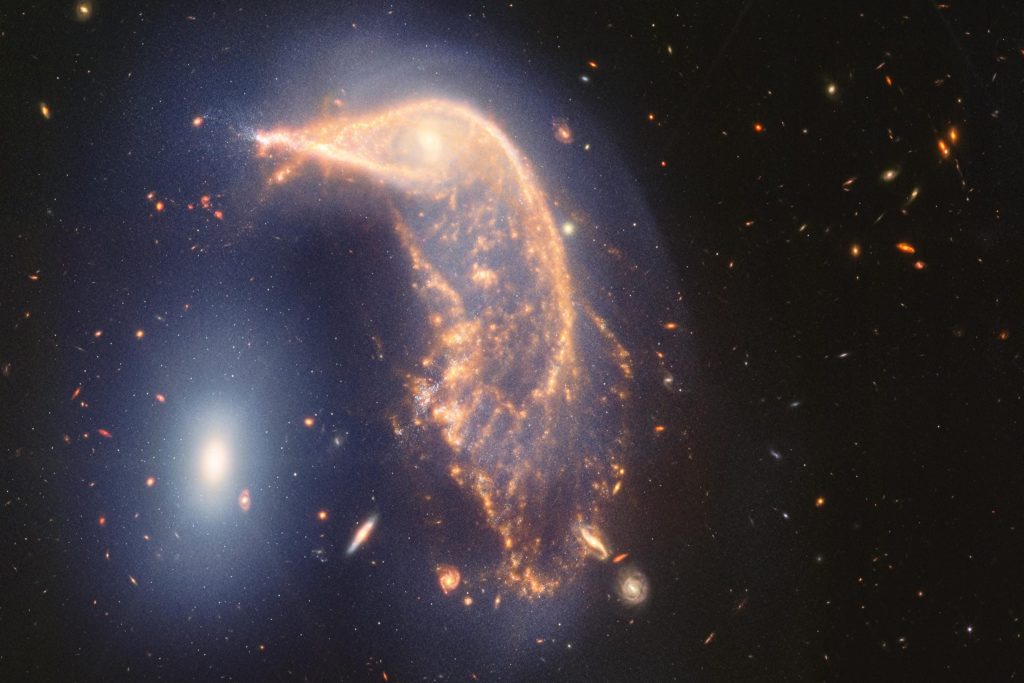Celebrating its two-year anniversary, the James Webb Space Telescope has captured stunning images of an interacting galaxy known as Arp 142. Using infrared techniques, Webb showed detailed interactions between the Penguin and Egg galaxies, revealing new star formation and providing insights into galactic dynamics and evolution. Credits: NASA, ESA, CSA, STScI
NASA’s James Webb Space Telescope has unveiled an infrared image of a pair of entangled galaxies in the latest installment of its ongoing observations.
of James Webb Space Telescope It operates around the clock, wowing researchers with highly detailed and incredibly accurate infrared images and data. These wavelengths of light invisible to our eyes have remained largely out of reach at this level of detail until Webb begins scientific observations on behalf of astronomers around the world on July 12, 2022.
To celebrate its second anniversary of scientific observations, the telescope observed Arp 142, a pair of interacting galaxies nicknamed the Penguin and the Egg. The main image combines near-infrared and mid-infrared light to visually highlight the interaction between the galaxies. Look for the faint, upside-down blue U-shape that envelops both galaxies. The Penguin has also recently seen a plethora of star formation, a “star party.”

Webb’s mid-infrared image of interacting galaxy Arp 142 seems to sing in primary colors. The cosmic background is a gaping darkness dotted with bright multicolored beads. The image was taken by the telescope’s mid-infrared instrument MIRI, which astronomers use to study cool, old objects, dust and extremely distant galaxies. Credit: NASA, ESA, CSA, STScI
Sharp Photos of Interacting Galaxies Mark Webb Space Telescope’s Second Anniversary
Two interacting galaxies celebrate their second anniversary NASA’s James Webb Space Telescopeprovides continuous observations, including images and highly detailed data, SpectrumThe activity has resulted in a “succession of discoveries” by astronomers around the world.
“Since President Biden and Vice President Harris unveiled the first images from the James Webb Space Telescope two years ago, the Webb has continued to unlock the mysteries of the universe,” he said. National Aeronautics and Space Administration (NASA) “With incredible images from every corner of the universe stretching back to ancient times, Webb’s capabilities are shedding new light on our celestial environment and inspiring future generations of scientists, astronomers and explorers,” said Director Bill Nelson.
“In just two years, Webb has transformed how we see the universe and enabled the world-class science that drove NASA to deliver this mission,” said Mark Crumpen, director of the Astrophysics Division at NASA Headquarters in Washington. “Webb is providing insights into long-standing mysteries about the early universe and ushering in a new era of studying distant worlds, while sending back inspiring images for people around the world and raising exciting new questions to answer. It’s now possible to explore every aspect of the universe like never before.”

This “penguin party” is roaring! The distorted spiral galaxy in the center (the penguin) and the compact elliptical galaxy on the left (the egg) are engaged in a lively embrace. Their interaction is revealed by a faint, inverted U-shaped blue glow in new near- and mid-infrared images taken by the James Webb Space Telescope to mark its second year of science observations.
Known as Arp 142, the two galaxies first came close to each other 25 to 75 million years ago, triggering “fireworks” – the formation of new stars – in the Penguin Galaxy. In the most extreme cases, the merger can cause thousands of new stars to form in the galaxy every year for millions of years. In the Penguin Galaxy, studies have found that about 100 to 200 stars form each year. By comparison, our own Milky Way galaxy (which is not interacting with any galaxies of a similar size) forms about six to seven new stars each year.
Credits: NASA, ESA, CSA, STScI
Insightful observations of galactic interactions
Specialization of telescope photography Infrared The observations, which are too subtle for our eyes to see, show the galaxies, known collectively as Arp 142, performing a slow cosmic dance. Webb’s observations NIR Camera (Near infrared camera) and Milli The images, taken by the Mid-Infrared Observatory respectively, clearly show that they are joined by a haze, shown in blue, resulting from the mixing of stars and gas.
Their ongoing interaction began 25 to 75 million years ago, when the Penguin Galaxy (catalogued separately as NGC 2936) and the Egg Galaxy (NGC 2937) completed their first transit. The Penguin and Egg Galaxy will continue to swing around, completing several more loops, before merging into a single galaxy a few hundred million years later.

Two penguins, two eggs. Very different color schemes. The Hubble Space Telescope captured visible light when observing Arp 142, nicknamed the Penguin and the Egg, in 2013. On the right is a near-infrared image of the same area from the James Webb Space Telescope. Credit: NASA, ESA, CSA, STScI
Penguin and egg evolution
Before they first approached, the penguin had a spiral shape; today, its galactic center shines like an eye, its loose arms form a beak, head, spine, and fanned tail.
Like other spiral galaxies, the Penguin Galaxy is very rich in gas and dust. The galaxy’s “dance” pulls on the Penguin’s thinner layers of gas and dust with gravity, causing them to collide in waves and form stars. Look for these regions in two places; they look like fish in its “beak” and “feathers” in its “tail.”
Surrounding these new stars is a smoke-like substance that contains carbon-containing molecules. Polycyclic aromatic hydrocarbonsWebb has been very good at detecting this dust, and also spotting a faint, deep orange dust arc that rises from the bird’s beak to its tail feathers.
In contrast, the Egg Galaxy’s compact shape has changed little. As an elliptical galaxy, it is filled with old stars and has much less gas and dust to pull apart to form new stars. If both were spiral galaxies, they would both end their initial “twist” with new star formation and swirling spirals (called tidal tails).
Another reason the eggs appear intact is that the galaxies have roughly the same mass, or weight, so the smaller-looking oval wasn’t swallowed or distorted by the penguins.
This video takes us around Arp 142, a pair of interacting galaxies nicknamed the Penguin and the Egg, 326 million light-years from Earth. The journey begins and ends with new mid-infrared and near-infrared images from the James Webb Space Telescope. Hubble Space TelescopeThe two are only 100,000 light years apart, making them relatively close in astronomical terms. milky way Our galaxy and its nearest neighbor, Andromeda, are about 2.5 million light-years away. This tour shows what happened after they interacted and how the blue haze merged. Also note the contrasting image of the spiral galaxy at the top right, which “disappears” in Webb’s mid-infrared image. Credit: NASA, ESA, CSA, STScI, Daniel Kirshenblatt (STScI)
The broader context of galactic interactions
The penguins and eggs are estimated to be about 100,000 light-years apart, which is pretty close in astronomical terms. For comparison, the Milky Way and our nearest neighbor, the Andromeda galaxy, are about 2.5 million light-years away. They will also interact, but in about 4 billion years. (See the video below.)
This scientific visualization of a computer simulation depicts the inevitable collision of our Milky Way galaxy and the Andromeda galaxy, also known as Messier 31. According to observations by NASA’s Hubble Space Telescope, the two galaxies, attracted by their mutual gravity, will collide in a near head-on collision about 4 billion years from now.
Now, look to the upper right and find a galaxy that’s not in this party. Cataloged as PGC 1237172, this edge-on galaxy is nearly 100 million light-years from Earth. It’s also very young and full of new blue stars.
Want one more party trick? If you switch to Webb’s mid-infrared-only image (the second image on this page), PGC 1237172 almost disappears. The mid-infrared mainly captures cooler, older stars and vast amounts of dust. The galaxy’s stellar population is so young that it “disappears” in the mid-infrared.
And look at the background. Webb’s image is teeming with distant galaxies, some of them spirals and ovals that look like they’re woven into a penguin’s “tail feathers,” others just shapeless dots scattered here and there. It’s a testament to the sensitivity and resolution of the telescope’s infrared instruments. (See Webb’s image for more details.) Observations in 2018 The telescope combines the infrared from NASA’s retired Spitzer Space Telescope with the near-infrared and visible light from NASA’s Hubble Space Telescope. Though these observations took only a few hours, Webb revealed much more distant, redder, and dustier galaxies than previous telescopes — one more reason to expect Webb to continue expanding our understanding of everything in the universe.
In this visualization, we look at the three-dimensional structure of Arp 142, a pair of interacting galaxies nicknamed the Penguin and the Egg, observed in near-infrared by the James Webb Space Telescope.
Arp 142 is located 326 million light years from Earth in the constellation Hydra.
The James Webb Space Telescope is the world’s premier space science observatory. Webb is unlocking the mysteries of our solar system, observing distant worlds around other stars, and probing the mysterious structure and origin of the universe and our place in it. Webb is the research and development arm of NASA and its partner, ESA.European Space Agency) and CSA (Canadian Space Agency).


